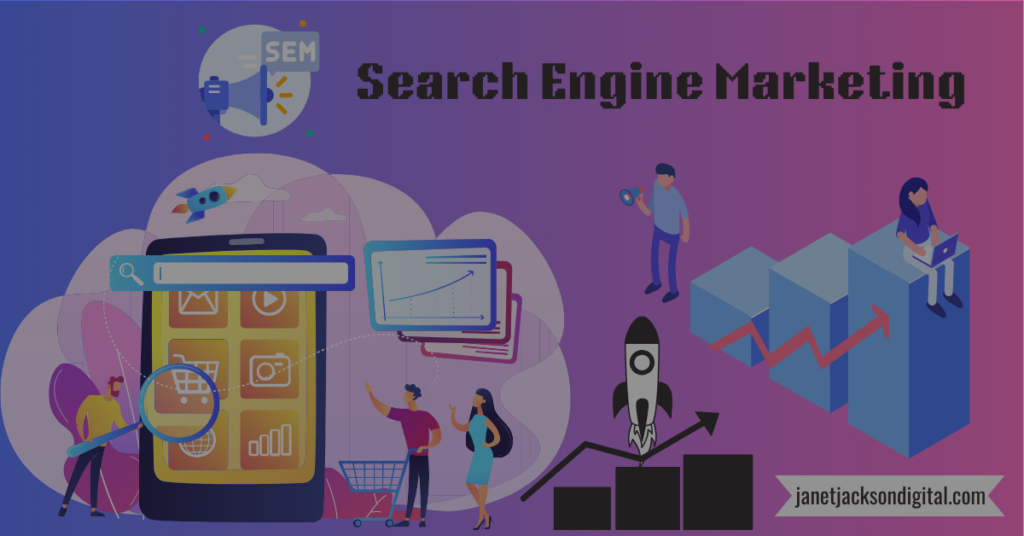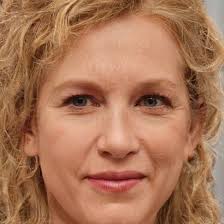Last Updated on August 12, 2024 by janetjacksondigital

Search engine marketing (SEM), the paid component of search marketing, is the acquisition of advertisements that show up on websites and in search engine results.
Search Engine Marketing: What Is It?
The definition of search engine marketing, or SEM, has grown along with the use of search engines. Originally used to refer to search engine marketing via search optimization, SEM has come to mean a particular paid search method that yields higher volume, more instantaneous results. Long-term tactics like search engine optimization (SEO) are employed to organically build credibility and long-term visibility.
Information is always available thanks to technology, but navigating this massive amount of data can be daunting. Search engine optimization offers visitors an easy approach to find the most authoritative website or the response to their question. Businesses can compete to get their products by utilizing the power of internet visibility.
Comparing SEO and SEM
Two marketing techniques that are effective in increasing online visibility are SEO and SEM. Even if “this” and “that” are distinct concepts, it’s vital to keep in mind that they are closely related. When utilized in concert or symbiotically, they enhance one another to the fullest extent possible.
- SEM is a type of paid search approach that increases visibility rapidly at an impression or cost per click (CPC) rate.
- In order to convince search bots that a website is a valuable representation of the query or inquiries, SEO is a strategy approach that aims to establish online authority. .
In order to choose the most pertinent queries to target. And to aid in landing page optimization. Both SEO and SEM mostly rely on keyword research. An SEO campaign would aim to produce a keyword-optimized response to a frequently asked query. Whereas keyword research for a SEM campaign might assist marketers in producing a better landing page for sponsored advertising. In either scenario, keyword optimization is necessary to satisfy users who click on the page that appears quickly in the search engine results page (SERP) and want additional information.
SEM Techniques
Keyword research is necessary for SEM campaigns in order to focus ad campaigns around the specific terms that your target audience uses. SEM strategies use sponsored techniques to show up on a page with Google AdSense, in a search engine’s (Google, Bing, Yahoo) results page (SERP), or on social media platforms like Facebook.
Faster results are usually obtained with paid search, or SEM, strategies. And they are only temporary while the advertisement is supported. SEM advertising can quickly raise brand exposure, revenue, and visibility. When there is intense competition for keywords. This might be a useful strategy for being recognized rapidly. SEM can be a useful strategy for a new company with little online presence, or it might highlight a website transfer or branding shift.
PPC advertising
Pay-per-click (PPC) advertisements can be bought links that show up higher in search engine results pages (SERPs) or adverts that show up on relevant websites or social media feeds. Whether or whether a click results in a conversion. The company is compensated each time an advertising or link is clicked.
Advertisement Auction
While it is possible to purchase links and advertisements to show up on search engine results pages. The largest buyer isn’t always the winner. There’s an auction where a number of elements determine the ad placement for each Google search or social media feed refresh.
These factors can include click-through rates on Facebook and Google, Google’s quality score, relevancy and/or keyword usage, and the amount of money a firm has allocated for pay-per-click.
CTR
The term “click-through rate,” or CTR, refers to the ratio of clicks an advertisement receives to total impressions. Whether or not an advertisement or link are viewed or interacted with. Its impression count is the number of times it loads or displays on a page. The PPC click-through rate is the number of times that purchased advertising are actually clicked.
CPC
Cost-per-click, or CPC, is the sum that the advertiser is charged each time a link or advertisement is clicked. The level of competition for a particular term, the ad auction, and the maximum amount allotted for each paid hit can all affect the cost per click (CPC), which is not fixed.
PPM
The cost-per-thousand, or cost-per-mille (CPM), is the amount an advertiser must pay for a thousand impressions. An impression is the quantity of times an advertisement or link has loaded on a search page, website, or social media feed; it does not always indicate interaction or clicks with the link or advertisement. The main goal of impressions marketing strategies is to increase brand recognition through increased visibility.
Strategies for SEO
Compared to SEM’s sprint to the finish line (or conversion/purchase click). SEO is a marathon. SEO is a long-term strategy that requires patience. And effort in order to develop evergreen web traffic naturally through building a valuable credible online presence. Hat in white By focusing on giving users a positive experience and sending Google the proper signals, SEO strategies can raise the quality of a website. There are three methods for doing this.
Optimization of Content (On-Page SEO)
Sending the correct signals to bots—that is, informing the search engine’s algorithm that a website is authoritative and relevant—requires building informative and linkable on pages seo a website that broaden its resource knowledge. This content is also carefully tailored to be both practical and potentially even enjoyable in order to suit the needs of a readership.
Building Links (Off-Page SEO)
Links Building from other websites can point to authoritative, excellent. And resource-worthy information (also known as optimized content). The search engines reward high-quality connections and resources that are easy to link to. Links assist in informing search engines about the website’s larger context and the importance of the high caliber information on it.
Boost Your SEO Strategy with These Proven Off-Page Techniques
Technical Search Engine Optimization
Technical SEO refers to a website’s base and backend architecture. It is composed of non-content elements such as site architecture. Security, mobile accessibility, and crawlability and speed. Enhancing technological attributes frequently leads to an almost instantaneous rise in the SERP.
What is Search Engine Marketing (SEM)?
Choosing an Effective Search Marketing Plan
The best techniques for online visibility are those tactics that support the achievement of specified objectives and cater to the unique requirements of the business. SEM is an excellent strategy for websites who want to sell products rapidly without worrying about customer base building or sustainability. SEO tactics are the blueprint for success for a business hoping to increase traffic and add value over time.
The most effective search engine marketing strategies integrate the capabilities of SEO and SEM. With keyword-rich, linkable material, this can help establish authority over time. It can also move fast and run a lot of advertisements.

My name is Janet Jackson Seo and I work as a SEO Expert. I appreciate the process of developing an innovative approach and employing logic, particularly when it concerns future studies and SEO optimization. As an SEO expert I have known how to set up SEO campaigns fully and how to monitor their achievements.





